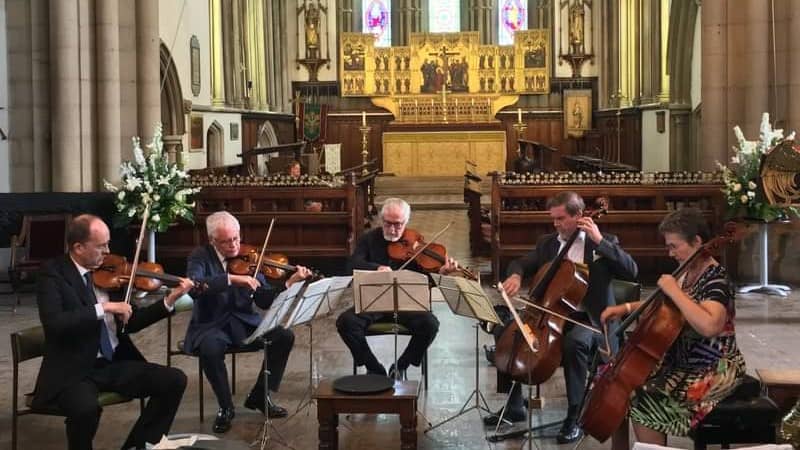
- This event has passed.
Friern Ensemble
28 March @ 12:45 pm – 1:45 pm
Tickets on the door (cash or card). Under 18s and carers go free
Doors open at 12:15 pm

Performers
Paul Willey
Violin
Margot Rusmanis
Violin
Ian Byrne Brito
Viola
Nigel Blomiley
Cello
Notes on the performers
The Friern Ensemble are made up of leading orchestral players. Nigel Blomiley and friends.
Paul Willey
Paul Willey (violin) studied at the Royal Academy of Music and won scholarships to complete his studies in Freiburg, Indiana and Sienna. He was Associate Leader of the City of Birmingham Symphony Orchestra before being appointed Leader of the Ulster Orchestra and subsequently Leader of the BBC National Orchestra of Wales. He now freelances, and appears regularly as guest leader of the English Chamber Orchestra, the Philharmonia, the Bournemouth Symphony Orchestra and other orchestras. He has performed as concerto soloist with various leading orchestras, and has played on BBC radio both as recitalist and as concerto soloist.
Margot Rusmanis
Margot Rusmanis (violin) studied at Trinity College of Music with Bela Katona and Dennis East, and was a member of the BBC Radio Orchestra for 10 years. She then freelanced in the classical and light music world including leading the String section of the original Come Dancing Orchestra! She teaches privately in Beaconsfield Bucks, and coaches at the Chiltern Music Academy as well as running music theory classes and coaching string chamber music in the school holidays.
Ian Byrne Brito
Ian Bryne Brito (viola) was born in the UK but brought up in Spain. He graduated from The Hague Royal Conservatory and completed a masters at the Royal Academy of Music. Since then, Ian has developed a successful international performing career and has won several prestigious awards and scholarships. He continues to perform and teach alongside his role as Manager and Viola Specialist with Stringers in London.
Nigel Blomiley
Nigel Blomiley is one of the most distinguished principal cellists in the country. Pierre Fournier, with whom he studied, described his playing as ‘very musical’ and ‘creating a marvellous atmosphere’.
Bernard Greenhouse described him as ‘a damn fine cellist’. Largely self-taught, Nigel did not begin any musical training until he was fourteen, six years later he was playing professionally and soon established himself as a principal player in the BBC Northern Symphony Orchestra.
Programme
Programme notes
Joseph Haydn (1732 – 1809)
Seven Last Words from the Cross Op.51
- Introduzione. Maestoso ed adagio
- Sonata I. Largo. “Pater, dimitte illis, quia nesciunt, quid faciunt”
- Sonata II. Grave e cantabile. “Hodie mecum eris in Paradiso”
- Sonata III. Grave. “Mulier, ecce filius tuus”
- Sonata IV. Largo. “Deus meus, Deus meus, utquid dereliquisti me”
- Sonata V. Adagio.”Sitio”
- Sonata VI. Lento. “Consummatum est”
- Sonata VII. Largo. “In manus tuas, Domine, commendo spiritum meum”
- Il terremoto. Presto e con tutta la forza
Haydn explains the origin and difficulty of writing the work, commissioned in 1786, in a 1801 preface:
“Some fifteen years ago I was requested by a canon of Cádiz to compose instrumental music on the Seven Last Words of Our Savior On the Cross. It was customary at the Cathedral of Cádiz to produce an oratorio every year during Lent, the effect of the performance being not a little enhanced by the following circumstances. The walls, windows, and pillars of the church were hung with black cloth, and only one large lamp hanging from the center of the roof broke the solemn darkness. At midday, the doors were closed and the ceremony began. After a short
Haydn
service the bishop ascended the pulpit, pronounced the first of the seven words (or sentences) and delivered a discourse thereon. This ended, he left the pulpit and fell to his knees before the altar. The interval was filled by music. The bishop then in like manner pronounced the second
word, then the third, and so on, the orchestra following on the conclusion of each discourse. My composition was subject to these conditions, and it was no easy task to compose seven adagios lasting ten minutes each, and to succeed one another without fatiguing the listeners; indeed, I found it quite impossible to confine myself to the appointed limits.”
At the request of his publisher, in 1787 Haydn produced a reduced version for string quartet: Haydn’s Opus 51. This is the form in which the music is most often heard today: a group of seven works .With the Introduction abutting Sonata I and Sonata VII joined by the Earthquake. The first violin part includes the Latin text directly under the notes, which “speak” the words musically.
- INTRODUCTION
- FIRST WORD – “Father forgive them, for they know not what they do”
- SECOND WORD – “Today you will be with me in Paradise “
- THIRD WORD – “ Woman, behold your son”
- FOURTH WORD – “My God, my God, why have you forsaken me ? “
- FIFTH WORD – “ I thirst”
- SIXTH WORD – “ It is finished “
- SEVENTH WORD – “Father into your hands I commenf my spirit” – EARTHQUAKE